| |
We stayed two days longer on the Kjalhraun camped at
Hveravellir, principally to mark out the route over the east
side of the lava field from Dúfufell to Kjalfell, but also to
pay a visit to the Strýtur Crater. The lava field was on the
whole very difficult to traverse, and the horses suffered con-
siderably on the march over this waste, where blocks and
mounds of black lava raised themselves in our way. In
olden days already, some cairns were built on the route from
Dúfufell to Kjalfell. A little south of Dúfufell for instance,
are half a sevre such on an elongated depressed lava mound.
The length of the mound is about 200 feet, with entrance
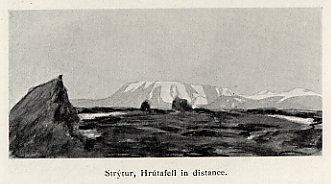
Strýtur, Hrútafell in distance.
from the west. In this so named Grettishellir (Grettirs
hollow) the outlaw Grettir is said once to have dwelt.
Somewhat further south and nearer Kjalfell, are two cairns
on a projecting spot in the lava. When I passed this part of
Kjalhraun in 1897, a raven was croaking in the vicinity, and
seeing a number of white objects lying by the cairns, I rode,
with some difficulty, to the spot, under the impression that the
raven was in the act of devouring a bird. I was however, very
disagreeably surprised on discovering that what had attracted
my attention were the bleached bones of horses and sheep,
which evidently long ago had been packed up under the
cairns in large quantities. Later I discovered that they
probably originated from the great disaster already referred to,
which happened in the autumn of 1780, and together with
other similar catastrophies, brought about the disuse of the
Kjolur route. In the autumn mentioned, some people from
Skagafjord had gone to the south to buy sheep, and on their
homeward journey over Kjolur together with their flocks, they
were taken by surprise by fearful snowstorms. Their friends
at home in the north thought that they had remaned in the
south country for the winter, but when the spring arrived
without their appearance, their friends became apprehensive,
and a search party was sent out after them. Dead sheep and
horses were found scattered round. One grey horse was even
found right down by Svarta, an hours ride southwest from
Kjalfell, at the spot since named Gránanes (Grey Naze). The
horses were found with their packs still on. A man
discovered the bodies of the party in a tent, and returned home to
fetch assistance for their removal, but when he returned
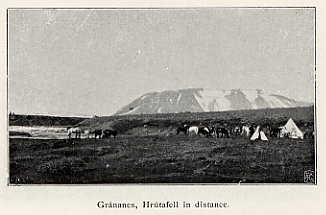
Gránaes, Hrútafell in distance.
with help, the bodies had disappeared. It was thought that
they had been plundered in the meanwhile & disposed of.
The remains of the animals have since been collected in
heaps and the cairns raised over them. Tears came to the
eyes of old Indridi at the sight of these mournful records,
and at the thought of the lamentation and misery caused by
the disaster.
While Magnús and Indridi were marking out the way over
the Hraun, Klein and I sought an approach to the crater
on horseback. We rode first of all west from Hveravellir
around the nearest eminence of the lava field, then turned
due south up through this, and after an hours ride
reached the brink of a mighty crater. It was about 60 feet deep
and 12—1300 feet wide. On its eastern edge, and also from
two spots in the congealed lava of the pit, rose remains of
old crater brinks in the form of pointed summits, whence
the crater receives its name of Strýtur. From the summit
of the eastern edge rising in perpendicular walls 120 feet
high above the bottom of the crater, we had a magnifi-
cent prospect far and wide over Kjalhraun, while Hrutafell,
with its three glaciers and Fulakvisi running beneath it, was
especially fine.
This splendid crater is much more easily approached than
for instance Hekia, and will probably, together with the
Kjalhraun lava deposits and Hveravellir, be frequently visi-
ted by tourists in the future. The afternoon was far advanced
when we returned to the camp, after having also made an
excursion to the eastern side of the lava field. Old Indridi
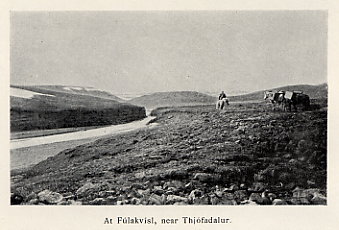
At Fúlakvísl, near Thjófadalur.
and his son-in-law had now helped us steadfastly and their
mission was ended. The route from Gilhagi to Kjalfell was
now marked out with temporary cairns, thanks to their
assistance, and Indridi was anxious to be home again, so
towards the evening, the two rode off in a northerly direction
over the sandbanks. — We remained over night at the camp,
and the next morning, the 16th of August, started south again
along the edge of Langjökull, west of Kjalhraun. We rode for
two hours in a furious sandstorm to the so called
Thjófadalur (Thiefs' dale), where a sheep stealer is said to have dwelt
long ago, and where there is a grazing place.
From Thjófadal we passed by Hrútafell in sleet and
showery weather, over some smaller hills in a southerly
direction toward Hvítárvatn with Fúlakvísl on the right hand and
Svartá on the left, our direction being Bláfell on the south
side of Hvítárvatn. From time to time, old bridle paths were
met with.
After several hours over lava, sand plains, and water-
washed naked sands, we descried the glaciers and the lake.
In semi-darkness we reached a group of ruins on the west
side of the lake, and here we pitched our tents in the
proximity of the little Tjarna. Here I had led excavations in 1897
and had spent several days on the spot on that account, so
Magnus was again able to take his old kitchen into
requisition. We had been 7 1/2 hours on the road since leaving
Hveravellir.
It was a' still and beautiful but dark evening. From the
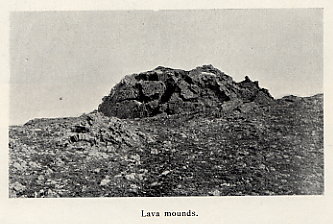
Lava mounds.
tents we looked out again over the green pastures, where
our horses, as on the previous occasion, grazed in company
with a herd of half wild colts, to the lake, which appeared
like a golden streak; and above it the glaciers, coming down
between the snow-clad mountains from the great white-toned
plane of Langjokull, over which it cleared up a little, while
clouds and rain were noticeable in other places. The solemn
stillness was only broken by the singing sound from the
swans on the lake, or by the geese and ducks as they flew
over the pastures, not to mention when the calving of the
glaciers was proclaimed by a distant report, followed by a
subdued roaring. A few icebergs floated in the lake.
According to the late Sig. Pálsson("Lvsing a Hvítárvatni" in
"Ţjódólfur" for the year 1883, 13th
October and 2nd November, respectively.)
the north end of the lake
is deep, at the southern end however the icebergs stranded
in five or six fathoms of water.
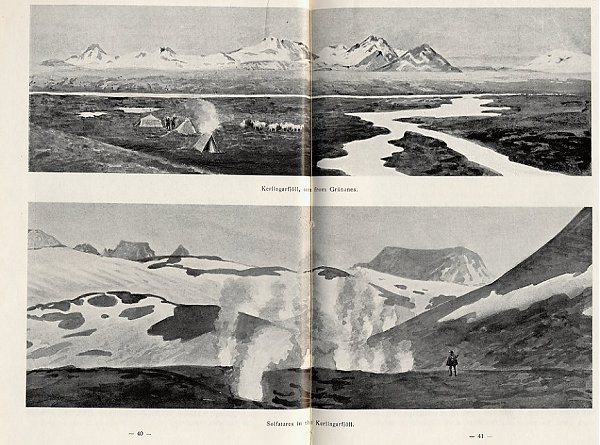
upper: Kerlingarfjöll, seen from Gránanes.
lower: Solfaters in the Kerlingarfjöll
The lake is rich in trout (bleikjur), while swans and
different species of wild ducks and geese breed there in the
summer, so that the sportsman can get a good bag. The spot
is however, seldom visited by sportsmen or anglers. In 1897
we met a sixty years old peasant, Snorre, in Hruni, who was
well acquainted with the spot, and had hunted there from
time to time, commissioned to procure swans, but otherwise
neither fishing nor shooting is carried on in this abundant
locality.
An old tradition relates that in olden times it was just as
profitable to have a fisherman at Hvítárvatn as in the best
fishing smack on the coast, which proves that the fishing
was carried on diligently then. Another legend tells of a
fisherman, who, when every one else had ceased to fish there,
still persevered in his labour for a long while, but as he
had no one to help him drag the net, hit on the idea of
using a mare and colt, which he possessed, for the purpose.
The foal he placed on one side of a bay, and took the mare
to the other, after having made the net fast to her. The
mare swam over to her foal and so the haul was made.
On the west side of the lake right opposite the spot on
which we were camped, and close up to the glacier, is a
hut called Karlsdráttur, which has a narrow opening on to
the lake, and here are found the ruins of a small dwelling,
a so named veidiskáli or fishermans' hut, where the above
mentioned fisherman had his abode.
In the early middle ages, there lay two farms by the lake,
but the colonization of Icelands interior is long since
abandoned, and today it is a long days journey to the nea-
rest inhabited spot towards the south.
|
|







![]() Zurück zu Inhalt
Zurück zu Inhalt![]() nächstes Kapitel
nächstes Kapitel